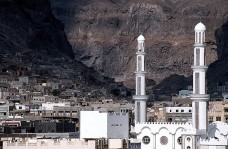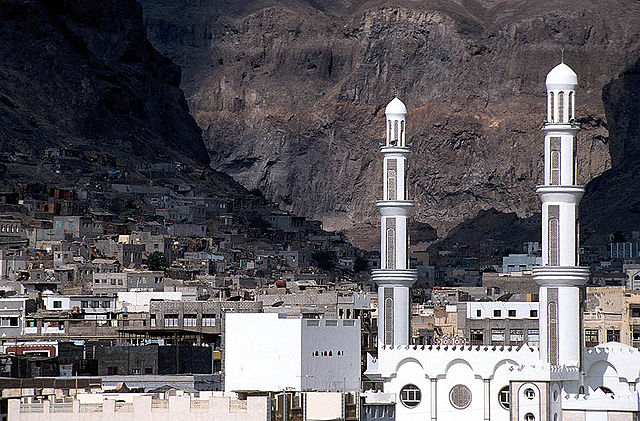
Photograph of the Old Town of Aden, Yemen by Jialiang Gao
The city has seen fierce clashes between government troops and Ansar al-Sharia militants over the past few months and the devastation of war is plain to see, with damaged buildings, spent ammunition littering the streets, and a smashed-up power and water network. City residents warn visitors not to try and approach the administrative complex or other government buildings, which they say are mined.
From his sandbagged office, Abyan Governor Jamal al-Aqil told IRIN
We never expected to see such destruction. We will have to start from scratch. Everything here is a priority…The governorate’s administrative complex, completed at the end of 2010, is completely ruined
Adding that demining must go on at the same time as work on restoring security and basic services such as water, electricity and sanitation.
Ghassan Faraj, secretary-general of Zinjibar local council, told IRIN that people whose homes and property were merely damaged, were the lucky ones.
The Yemeni army on 12 May launched a large-scale offensive on all Ansar al-Sharia strongholds, and in mid-June, the Defence Ministry announced that the militants had been driven out of the governorate, including the cities of Zinjibar and Zaar, where the militants had been dug in for over a year.
Hundreds of internally displaced families have returned to their homes in Jaar, Lawdar and Zinjibar since fighting subsided last month, but many areas have been contaminated with potentially fatal landmines and unexploded devices and there is inadequate public awareness of the dangers, said Médecins Sans Frontières (MSF) on 13 July.
Salim al-Tam, his wife and five children have just returned to Zinjibar, but they are already planning to leave having seen the problems: “We found nothing here to help us survive. No food, no water, no shelter,” al-Tam told IRIN. “We are seeking a better place outside Zinjibar to shelter in until conditions get better here.”
Reports indicate that nearly 150,000 people fled their homes in Abyan to the neighbouring Aden and Lahj governorates when fighting began in May 2011.
In Jaar city, where the destruction is not as severe as in Zinjibar, government teams have begun to repair the electricity grid, and citizens are also beginning to get water, said al-Aqil.
Ansar al-Sharia, an offshoot of al-Qaeda in the Arabian Peninsula, claimed responsibility for killing more than 90 soldiers in May when a suicide bomber dressed in army uniform blew himself up during a parade rehearsal in the capital, Sana’a.
Assessing needs, encouraging returns
The government and aid agencies are currently assessing needs in Zinjibar and the surrounding area, Barry Came, a public information officer with the UN World Food Program (WFP), told IRIN on 14 July, adding that a WFP team is scheduled to go to the area next week. He said the priorities after the “very heavy destruction” would be water, shelter, food, sanitation and power.
Meanwhile, UN agencies, the government, and local and international NGOs have set up a working group, headed by Minister of Public Works Omar Abdullah al-Kurshumi, which is providing technical assistance to aid planners regarding how best to conduct assessments of damaged property, said Edward Leposky, a public relations officer with the UN Refugee Agency (UNHCR).
WFP, the UN Children’s Fund (UNICEF), the UN Office for the Coordination of Humanitarian Affairs (OCHA) and the World Health Organization (WHO) are drafting an Abyan and the South Inter-Agency Response Plan, which is partly intended to encourage the return of displaced families.
WFP is aiming to conduct a general food distribution for 15,000 displaced households within Abyan and provide three months of food rations to encourage around 10,000 families currently displaced in Aden to return to their homes in Abyan, WFP’s Came said, adding that WFP is already supporting 140,000 internally displaced persons (IDPs) in Aden and Lahj governorates.
Alison Parker, chief of communication and advocacy at UNICEF, told IRIN
We have pre-positioned supplies in WASH [water sanitation and hygiene], child protection and nutrition to respond as soon as access is possible to the larger population
Ali Al-Yazidi, minister of local administration, said the government is planning to establish new camps for those IDPs whose homes were damaged or destroyed – in their own villages, to help persuade people to return. “We will work day and night, even during Ramadan, to prompt returns of displaced families,” he said.
Yemen’s cabinet on 19 June approved the establishment of an Abyan reconstruction fund with an initial capital of YR10 billion (US$47 million), which includes contributions from the government, donor states, Yemeni business people and expatriates.
ay/cb




